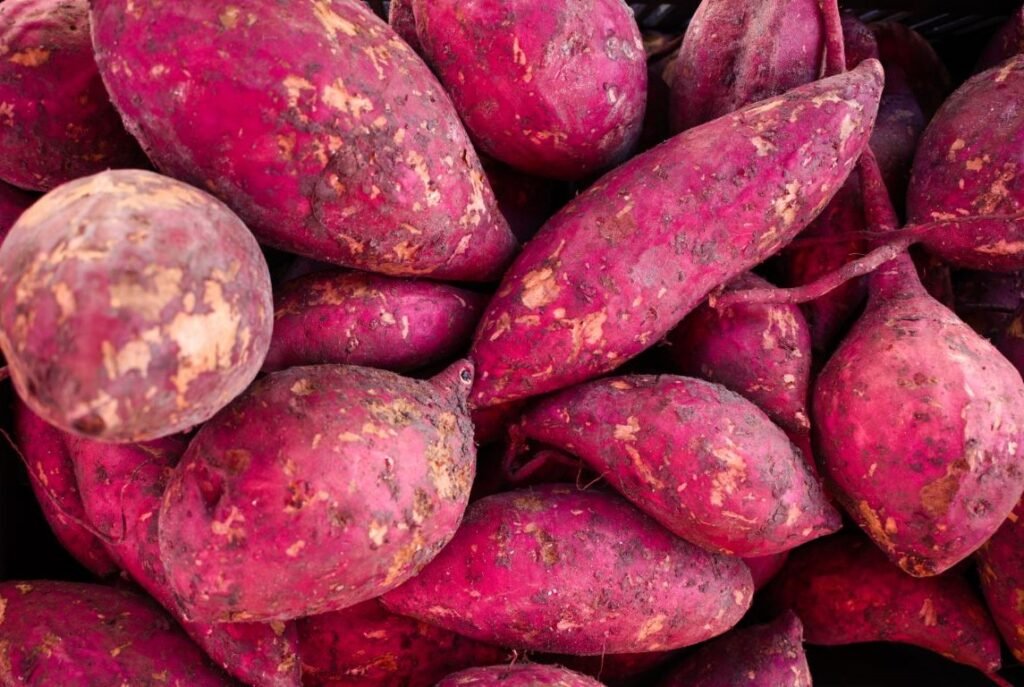Introduction to Pounded Yam
Pounded yam is a cherished staple food originating from Nigeria, renowned for its smooth texture and versatility. This traditional dish holds significant cultural value, not only as a staple in households but also as a symbol of hospitality and community in Nigerian society. The origins of pounded yam can be traced back to various ethnic groups, notably the Yoruba and Igbo, who have incorporated it into their culinary practices for centuries. Its preparation typically involves boiling yam tubers until soft and then pounding them into a stretchy, dough-like consistency, making it the perfect accompaniment for a variety of soups and stews.
Pounded yam is consumed across Nigeria, adapting to regional preferences and culinary styles, from the spicy egusi soup of the southwest to the rich, palm oil-based soups of the southeast. This dish is not only a favorite among locals; the Nigerian diaspora has also embraced pounded yam, ensuring that its popularity transcends geographical boundaries. It often plays a role in ceremonial events, celebrations, and gatherings, reflecting the importance of food in bringing people together.
Nutritionally, pounded yam is valuable, primarily composed of carbohydrates, making it a substantial energy source. When combined with nutrient-rich soups such as ogbono or okra, it provides a balanced meal that is both satisfying and nourishing. Furthermore, pounded yam is gluten-free, catering to those with dietary restrictions. Its adaptability, nutritional benefits, and cultural significance contribute to its status as a culinary delight within Nigerian cuisine, celebrated not only for its taste but also for its role in fostering connections within communities.
Ingredients and Preparation Method

Pounded yam, a cherished staple in Nigerian cuisine, is made primarily from specific varieties of yam. The most commonly used types are white yam and yellow yam, both known for their starchy consistency and ability to yield a smooth, stretchy texture when pounded. Selecting the right yam is crucial for achieving the desired results; thus, when shopping for ingredients, one should seek firm, fresh yams without any blemishes or signs of spoilage.

Once the appropriate yams are selected, the preparation begins with proper washing to remove dirt. Following this, the yams must be peeled and cut into manageable chunks, typically around one to two inches in size. This sizing facilitates even cooking and ensures a consistent texture. After cutting, the yam pieces should be placed in a pot and covered with water, enough to submerge the yams sufficiently. Cooking the yams requires boiling them until they are tender, which usually takes about 20 to 30 minutes, depending on the size of the chunks.
After cooking, the next step is to pound the yam. Traditional methods involve using a mortar and pestle, which allows control over the texture but can be labor-intensive. For those who prefer a modern approach, electric pounders or stand mixers equipped with a paddle attachment may be utilized to simplify the process. Regardless of the method, the key is to pound the yam until it reaches a smooth, stretchy consistency without any lumps. It is often beneficial to add a small amount of the cooking water to achieve the ideal texture. If hand-pounding, a little water can also help in easing the process while ensuring a fluffy end product.
To enhance the delight of pounded yam, serving it hot alongside traditional soups such as egusi or ogbono can greatly elevate the experience. The unique texture and warm temperature of pounded yam pairs beautifully with various accompaniments, making it a truly versatile dish in Nigerian gastronomy.
Serving Suggestions and Pairings

Pounded yam, a staple in Nigerian cuisine, is not only renowned for its smooth and stretchy texture but also for its versatility in various culinary pairings. Traditionally, this delightful dish is served with an assortment of rich and flavorful soups and stews that elevate the dining experience. Popular companions to pounded yam include egusi soup, a hearty melon seed-based dish, and efo riro, a vibrant spinach stew enriched with assorted meats and spices. Other notable pairings are the robust ofada sauce, which boasts a unique flavor profile derived from locust beans and assorted peppers.
Beyond these traditional combinations, pounded yam can be enjoyed with a variety of innovative accompaniments. For instance, it can be paired with light, creamy sauces that consist of palm oil, seafood, or grilled meats. These combinations not only refresh the palate but also showcase the adaptability of pounded yam in fusion cuisines. This dish is suitable for various meals, ranging from casual family gatherings to formal celebrations. Its versatility allows it to be a fitting centerpiece on any dining table.
In addition to traditional and modern pairings, the presentation of pounded yam can also enhance its appeal. Innovative serving styles, such as shaping the yam into small balls or presenting it in elegant bowls with garnishments, can elevate a simple dish into a visually striking centerpiece. Whether served during a festive occasion or a cozy family dinner, pounded yam remains an inviting option that delights both the eyes and the taste buds. Its cultural significance in Nigerian heritage makes it a cherished choice for gatherings, celebrating the richness of culinary traditions.
Cultural Significance and Variations
Pounded yam holds a significant place in Nigerian culture, transcending its status as a humble dish to embody a symbol of tradition and community. Traditionally served with various soups and stews, such as egusi or ogbono, pounded yam is more than just sustenance; it is often a centerpiece of social gatherings, celebrations, and rituals. The act of making pounded yam is itself a communal experience, typically involving family and friends, which fosters a sense of unity and shared identity. Whether during weddings, festivals, or religious ceremonies, this dish plays an integral role in the culinary heritage of Nigeria, often served as a sign of hospitality and respect toward guests.
Regional variations in the preparation and serving of pounded yam also reflect the diversity within Nigerian culture. Different areas of the country utilize distinct types of yam, leading to unique textures and flavors. For instance, some regions may favor the use of white yam while others may choose yellow yam or even cocoyam as substitutes. These adaptations are often influenced by local agricultural practices and availability, showcasing how pounded yam can vary without losing its essential appeal. Additionally, alternative preparation methods have emerged, including the use of yam flour, which requires less manual labor and offers a quick and convenient option for busy households.
In summary, the significance of pounded yam extends beyond its taste and nutritional value. It serves as an enduring link to cultural identity, heritage, and community values within Nigeria, illustrating how culinary practices are deeply interwoven with social and cultural narratives. This iconic dish adapts and evolves while still honoring tradition, further solidifying its unique place in the heart of Nigerian society.


